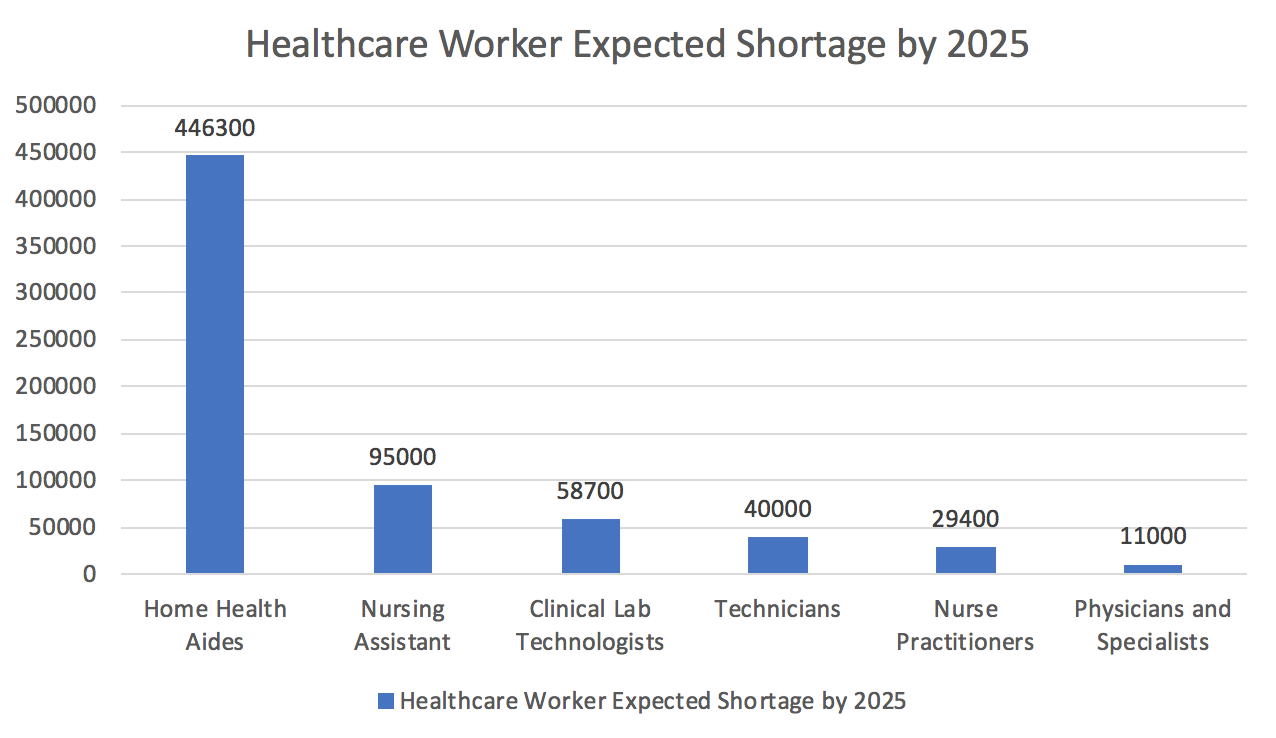#2020Trends: The Changing Future of Work
It’s here! The last post in my new blog series on 2020 trends in healthcare has arrived. So far, we’ve covered the tipping point in value-based care, the “retailization” of care, care model innovation, the ever-growing MA Market and increasing pressure on Rx pricing. I truly believe each of these trends will make a significant impact on healthcare not just this year but throughout the next decade—but perhaps none more so than the final trend: The changing future of work.
Growth in healthcare employment is going to explode in this decade – According to Bureau of Labor Statistics (BLS), by 2025 there will about 2.3 million new jobs in healthcare. New demands, including an aging and sicker population, are creating a shortage of clinical workers and physicians in the United States.

Source: Mercer’s US Healthcare External Labor Market Analysis (2017); Calcullation by Mercer’s Workforce Strategy and Analysis Practice
On top of that, we are seeing an increase in physician burnout. According to a 2018 Survey of American physicians by the Physician Foundation, 78% of physicians sometimes, often or always experience feelings of burnout. Hence, the future of work is top of mind for Health System leaders. In addition to other strategies to deal with shortage and burnout problems, leaders have to heavily rely on using game changing technologies for the digital workforce. RPA/AI/ML can all play a role in taking some of the burden off of the human capital so that healthcare workers can be freed from repetitive, mundane jobs and spend more time on patient care and other activities better suited to their strengths.
Bots are Changing the Game
Research suggests up to 60% of task-based work in healthcare can be automated. It also suggests that the healthcare industry is poised to begin an industry-wide transformation in how work gets done. In a recent survey, 68% of healthcare executives said that by 2022, every employee will have bots employed to help them do their work. Digital Workforce technologies like Robotics Process Automation (RPA) combined with data, AI and ML are delivering major productivity benefits and innovation for companies that are too substantial to ignore. In order to realize the benefit from productivity gains and reduce costs, organizations will need to examine the impact of the digital workforce on their human workforce. Some jobs will shrink, others will grow and the potential for change in the nature of every job is limitless.
Man & Machine Working Together in Patient Care
As automation begins to lift the administrative burden on clinical providers, nurses and physicians will be able to devote more time and attention to patient care and advocacy. RPA-driven improvements in quality, speed and accuracy of documentation and administrative tasks in care settings can make a life-saving difference. One study found that increased automation of medical records and documentation in hospital stays led to a 15% decrease in the odds of in-patient deaths. While this trend has just begun, we are going to see an acceleration of man and machine working together in the new decade.
AI & ML in Care Management
Advanced analytics and machine learning solutions are also beginning to hit back against some of the most persistent and challenging issues in healthcare. New predictive models offer providers a powerful new way to identify high-risk factors in time to make a meaningful difference for patients. We’ve seen examples of this in our work with a custom developed ML model to predict pregnancies at risk for low birthweight. Using the model, Amitech was able to identify 2,600 more at-risk pregnancies per year for a potential medical cost-savings of $8.3M.
Additional examples of the possibilities for higher-quality, coordinated care posed by automation exist in the midst of our current crisis. Although hospital backlogs are hardly a new challenge in healthcare, when diagnosis of a swift and lethal disease is held up by massive backlogs of clinical documentation and x-rays waiting for review, a combined model of RPA and ML with a proven ability to compress diagnosis timelines by 50% or more could be a literal lifesaver. When used effectively, examples of the digital workforce like this can augment humans and have a significant impact on efficiency, quality and cost of care.
Expanding Access with AI
Using AI for virtual visits and pre-visit information collection with patients is already expanding access to an increasingly limited number of clinicians. Providing more timely and convenient access for patients means improved care, higher volumes and increased patient satisfaction. In the rural communities served by Winona Health, RPA and AI provide a convenient way for more than 1,000 patients to use Smart Exams and increase access to services without any increases in staffing.
Managing the Transformation
The key to success for companies is to figure out how digital workforce technologies (automation combined with data AI, and ML) can enhance the work of humans and provide a superior and more fulfilling work experience that is better suited to our strengths. In this way, digital labor can be used to augment human work and create space for companies to develop a competitive advantage beyond automation. If you’d like to learn more about how we’re helping other leaders in healthcare navigate this journey, please contact us.





